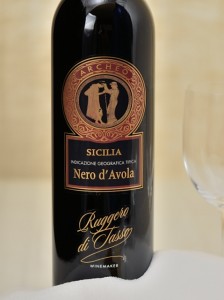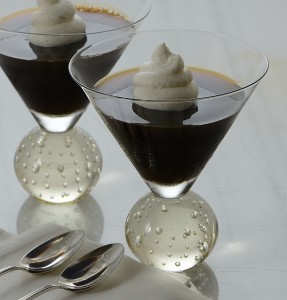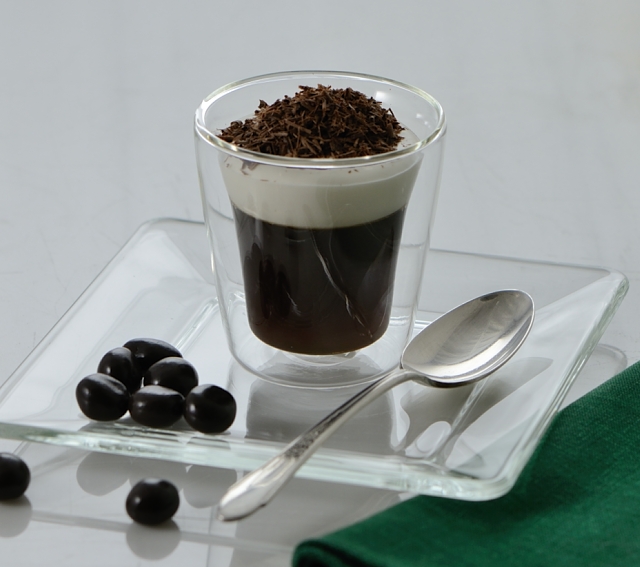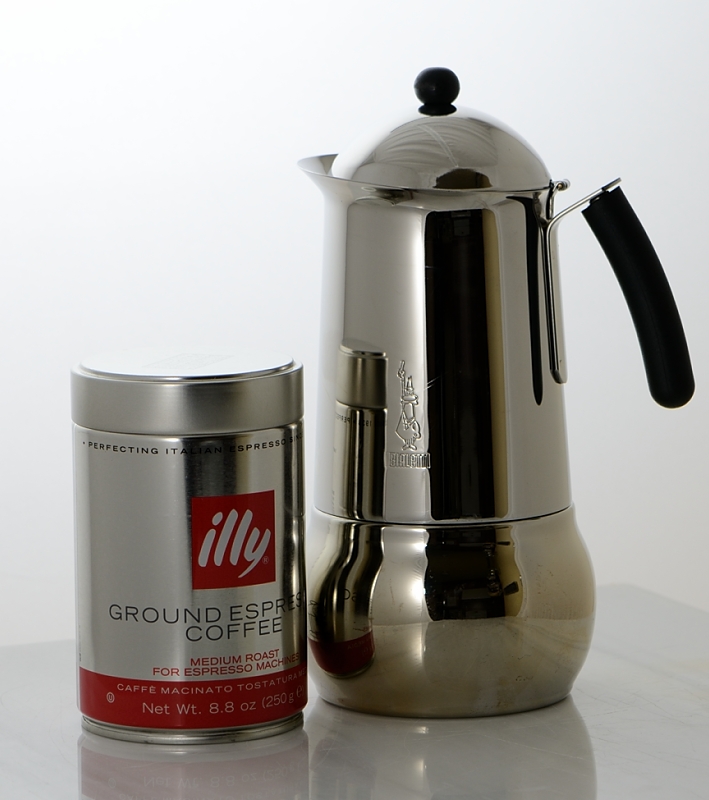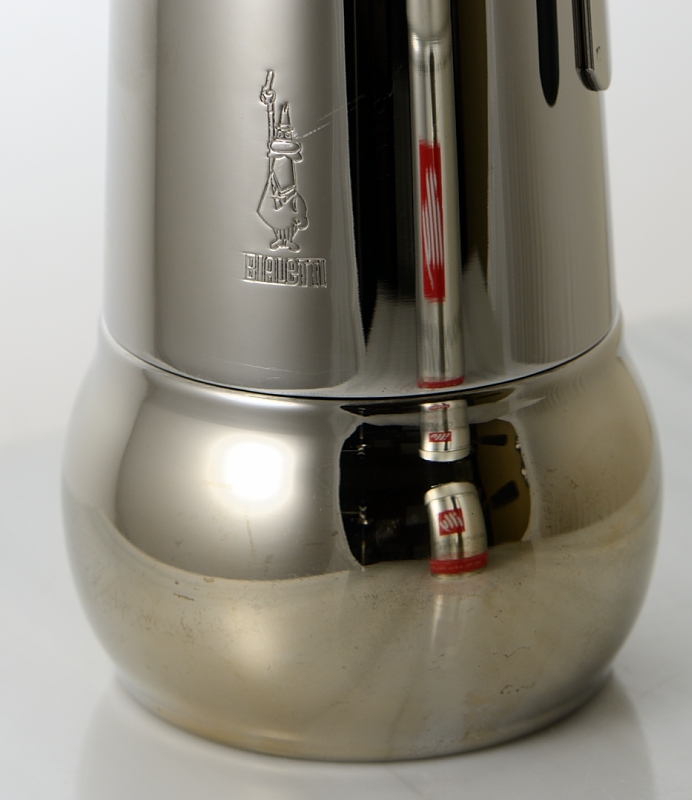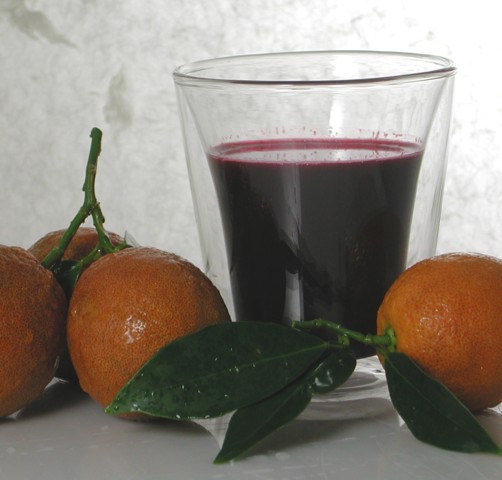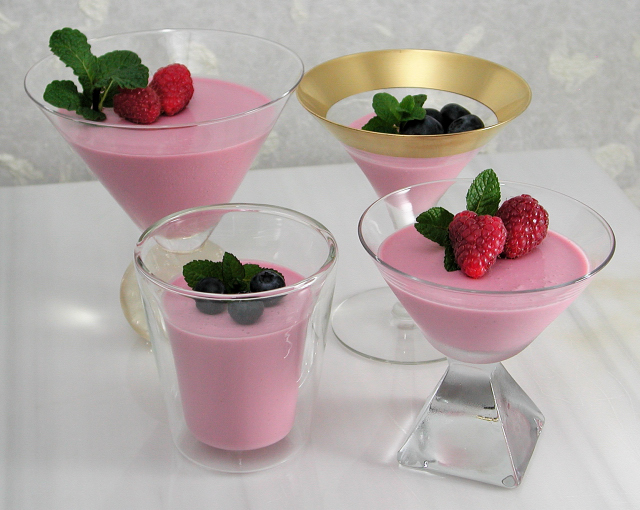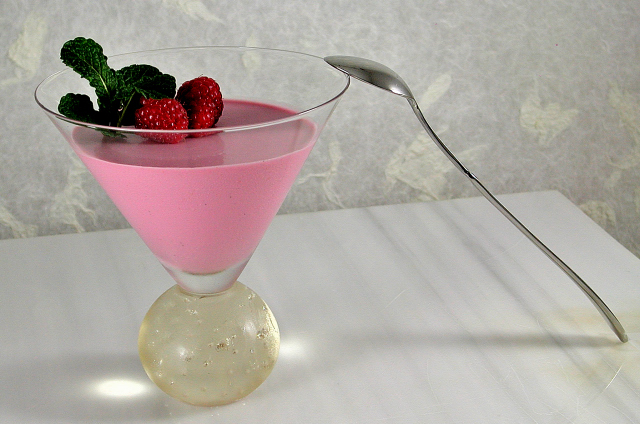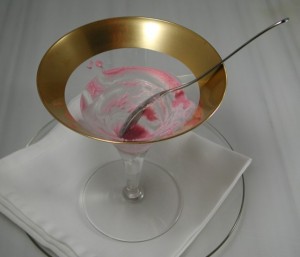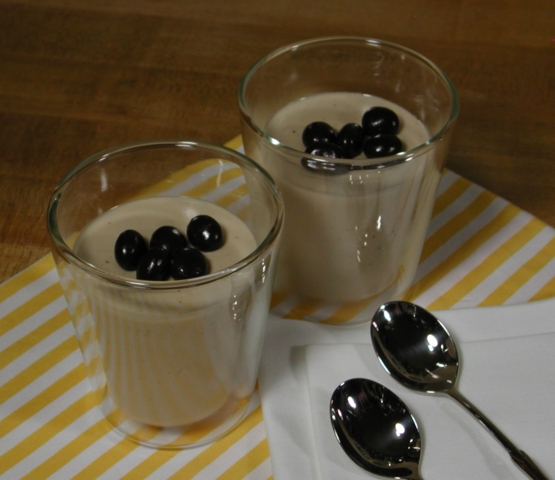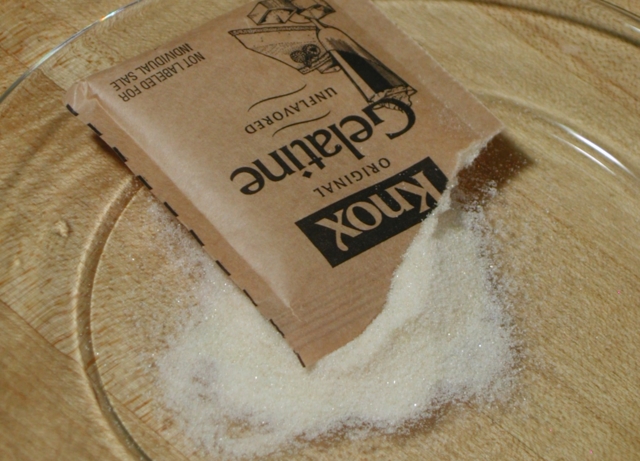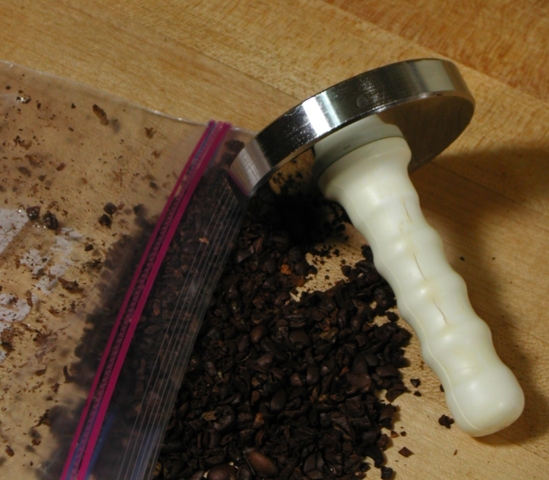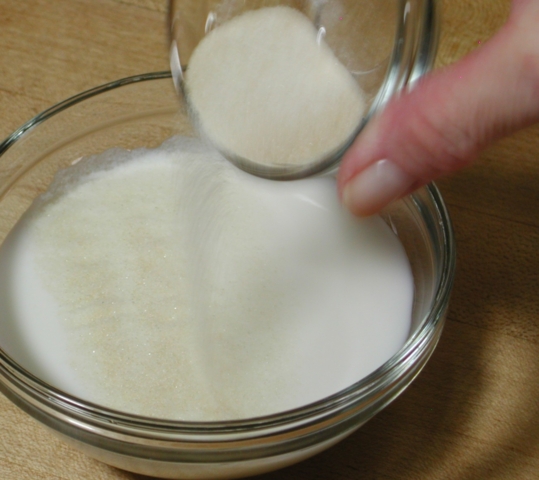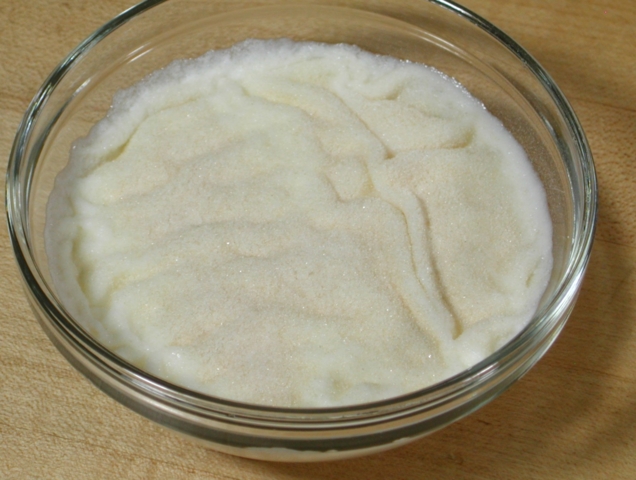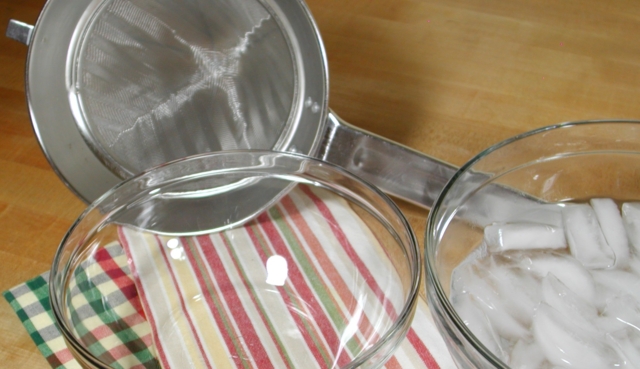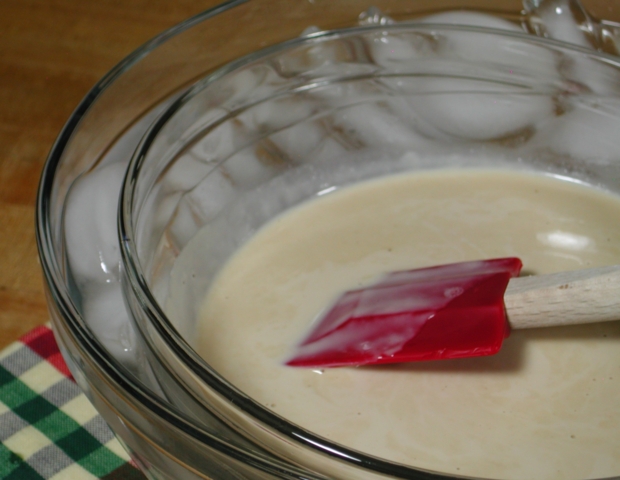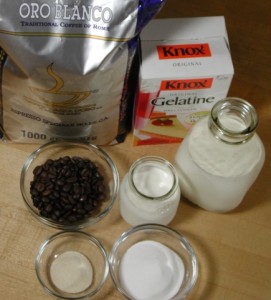Topic Index
The font size for a topic word is sized by the number of articles that reference that topic. The more articles the bigger the font.
Click on a word to search for posts with that topic. This page will reload with the search results.
Mint Chocolate Chip Panna Cotta
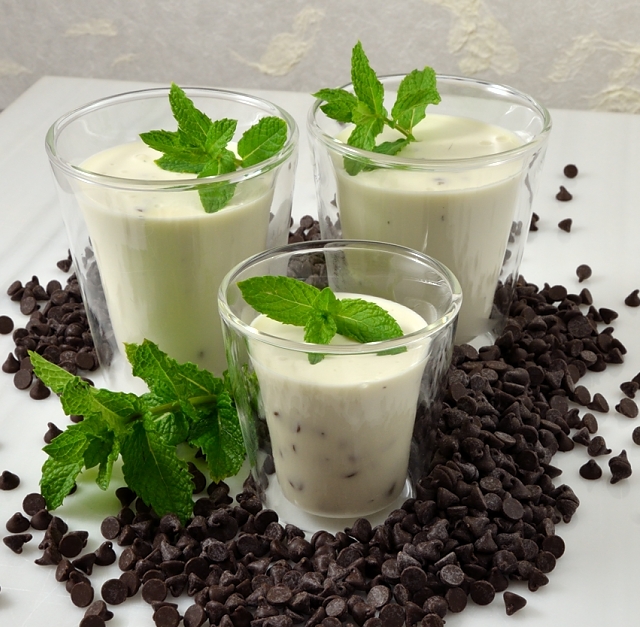
I guess I should add to this title “…another in an ongoing series.” Who knew that when I started writing I would wind up seeing the world through Panna Cotta colored glasses? Who knew it would come to this – when I think of a flavor I assign it an up or down vote on Panna Cotta worthiness value.
Espresso – check
Blood Orange – check
Gelatina di Nero d’Avola – Nero d’Avola Wine Gelatin
Bonnie, old friend and lover of all things Sicilian, this one is for you. This is one very adult homemade jello. Read the remainder of this entry »
Not Giada’s Espresso and Chocolate Jellies – Synchronicity
Okay, so you are wondering about the title. I can hear you all now. Adri, that is SO not you. What are you thinking, writing a title like that? What’ll people think? Kinda snippy, Dudette! Let me set everyone straight right now. Don’t think anything about it, and since you asked, yes, I like Giada DeLaurentiis. I like her a lot. She makes some great Italian food, and she makes it accessible. She is, as they say in the biz, relatable. The stories, the laughs, the Italian family, the neighborhood in which we both grew up. Yes. I shall proclaim it now. I, Adri Barr Crocetti, am a fan. Giada – for all the great recipes and all the inspiration, mille grazie.
Moving along. Just a few days ago Bart and I were talking about my blog articles and making a list of subjects under consideration. Among them was one of my fave rave summer desserts, Gelatina di Espresso. Espresso Gelatin. Homemade Espresso Jell-O. Call it what you will. I love it, especially on a scorching hot summer day. I entered it on my list and moved on.
Saturday morning I looked at the Food Network lineup I saw that Giada D. was going to do Espresso Chocolate Jellies. That sounded intriguing, so I took a look. Her dessert consists of a layer of chocolate covered with a mixture of instant espresso and Kahlua set with gelatin and topped with whipped cream. Mine is not. Mine is pure unadulterated espresso set with gelatin and topped with sweetened vanilla scented whipped cream. See? That’s all I meant by my title. Two different recipes.
I first tasted this very adult dessert in July of 1971 – on a night train from Milan. After a wonderful and very elegant dinner, it was time for dessert. And I could not believe I was being served Jell-O. I came halfway across the world for Jell-O? No way. Except it was true, and as it turned out, I was glad. One taste and I was transported to the world of adult desserts. Not too sweet, with the bitterness of Espresso, this was a soft gelatin that surrendered to the heat of my tongue. This was not my mother’s Jell-O.
In another twist to this story, and this is where the synchronicity comes in, we celebrated National Train Day this past Saturday, in honor of our great American railroads. I love trains, and I traveled all through Europe on them. So today, along with celebrating American trains and Amtrak, I salute Italian trains, the trains that introduced me to Gelatina di Espresso and the last trains in the world where the conductor kisses the passport photograph of a woman he finds particularly beautiful. Viva i treni!
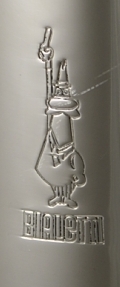 Alfonso Bialetti’s Italian stovetop espresso makers rocked the coffee world when they first appeared in 1933, and they dominate the market to this day. Known as Moka Express, Bialetti’s original stovetop espresso maker has remained almost unchanged since 1933 save for one decorative addition – the chubby mascot on each coffee maker L’Omino con i baffi – The Little Man with a Moustache is Sig. Bialetti himself. Familiar to us all, these darlings of the Italian design world come in sizes ranging from single serving all the way up to 18 cups. (The standard of measure for a cup in a Moka pot is 1 cup =2 oz.) Steam does the work in this style of espresso maker, and it does it quickly, which matters a lot if you have a recipe that calls for 2 standard U.S. cups (a total of 16 oz.) of espresso, as this one does. These iconic babies with their easily recognizable octagonal shape continue to live up to their maker’s promise of allowing customers to enjoy in casa un espresso come al bar – an espresso in the home just like in a coffeehouse.
Alfonso Bialetti’s Italian stovetop espresso makers rocked the coffee world when they first appeared in 1933, and they dominate the market to this day. Known as Moka Express, Bialetti’s original stovetop espresso maker has remained almost unchanged since 1933 save for one decorative addition – the chubby mascot on each coffee maker L’Omino con i baffi – The Little Man with a Moustache is Sig. Bialetti himself. Familiar to us all, these darlings of the Italian design world come in sizes ranging from single serving all the way up to 18 cups. (The standard of measure for a cup in a Moka pot is 1 cup =2 oz.) Steam does the work in this style of espresso maker, and it does it quickly, which matters a lot if you have a recipe that calls for 2 standard U.S. cups (a total of 16 oz.) of espresso, as this one does. These iconic babies with their easily recognizable octagonal shape continue to live up to their maker’s promise of allowing customers to enjoy in casa un espresso come al bar – an espresso in the home just like in a coffeehouse.
Gelatina di Espresso
makes 4 servings, ½ cup each
1 envelope (1/4 oz.) KNOX Unflavored Gelatine
2 tablespoons cold water
2 cups ( 16 ounces) hot espresso
3 to 4 tablespoons granulated sugar
1 cup heavy cream
1 teaspoon granulated sugar
½ teaspoon vanilla extract
bittersweet or semi-sweet chocolate shavings
Before we begin – don’t be put off by the idea of using gelatin. Once you understand it, you’ll be glad you took the time to learn. Classic gelatin technique consists of two steps, bloom and dissolve. If you are new to gelatin or just need a refresher, click here to see my post on Espresso Panna Cotta and come up to speed with step by step directions. For even more information click here to see my post on Blood Orange Fruit Gelatin.
Brew espresso. While espresso brews, pour 2 tablespoons cold water in medium bowl and sprinkle gelatin over. Set aside to soften for 5 minutes, do not stir. When espresso has brewed and gelatin has softened, pour 2 cups (16 oz.) hot espresso over gelatin mixture and stir to combine and melt gelatin. Add sugar, a tablespoon at a time until desired degree of sweetness is achieved. Keep in mind you will eat this cold, so a little extra sugar may be necessary no matter how perfect the sweetness level seems when you first try it. Place bowl over ice water bath, stirring occasionally to promote even cooling.
Pour mixture into serving glasses and refrigerate until set, 2 hours or overnight. If you are feeling particularly playful, rather than serving this dessert in the traditional wine glasses or coupe dishes, use coffee cups or espresso cups. The whimsical touch will delight your guests and guarantee smiles all around.
Beat heavy cream with sugar and vanilla, until very soft peaks form. To serve give each gelatin a dollop of whipped cream. If you are a fan of dark chocolate like Bart, then finish it with a dusting of either bittersweet or semi-sweet chocolate shavings.
And for the gardeners out there – don’t discard those espresso grounds, they’ll give your tomatoes a great nitrogen boost!
Note: You can click on any picture to see a slide show with even more pictures!
I have no affiliation with any product, manufacturer, or site mentioned in this article.
Blood Orange Panna Cotta
So dramatic. So exotic. Winter in Sicily. Breakfast in the finest hotel. I am talking about blood oranges, Moro blood oranges in particular. Does any citrus make such a statement? This fruit will have you seeing red.
Cut a Moro open and see brilliant crimson throughout. Juice it and see an opaque liquid as dark as blood. Drink it and experience the marriage of orange with a hint of raspberry over a pedal point of tartness.
This is orange juice for adults. I figured that the juice, along with being a magnificent drink on its own, would be an unbeatable component in panna cotta. There are several kinds of blood oranges – Moro, Tarocco and Sanguinello being the most common. Although they all ripen in winter, the Moros ripen first and are at their peak right now. You can find them in Farmer’s Markets and many supermarkets these days. Lucky me, I find them in my back yard. I love my blood orange trees, but the Moro is my favorite – especially at this time of year. It is a wildly productive tree and now its branches are heavy with a medium sized fruit. The skin is quite rough and sports an enticing crimson blush. And, thank you Mother Nature, Moros are virtually seedless. If you would like your own blood orange tree, check out Four Winds Growers, a great source for hard to find citrus.
Let’s get to the recipe – for a step by step discussion of Panna Cotta and the proper use of gelatin, take a look at my recipe for Espresso Panna Cotta. You will find lots of explanations and photos there. I cooked up several versions – all cream, cream and milk, more milk than cream – more gelatin – less gelatin. I settled on 1 cup of cream and ½ cup of milk. All cream and the dessert was undeniably voluptuous, but the orange flavor was somehow masked, muted, while the 2 to 1 cream to milk ratio allowed for a pleasant creaminess and a startlingly clean orange flavor. I settled on 1 teaspoon of gelatin to allow for a softer set. If you prefer a firm set, go ahead and increase the gelatin to 1 1/4 teaspoons. This panna cotta is something of a trickster – its dusky rose hue belies a bright clean orange flavor. So get busy, find some Moro blood oranges, or any other variety, and make some Panna Cotta. A word about the choice of oranges. Not all blood oranges are created equal. Moros are much darker than the other varieties, so if you use Sanguinellos or Taroccos, your Panna Cotta will take on a lighter hue. The varieties vary in sweetness, you may have to adjust the sugar.
Blood Orange Panna Cotta
makes 4 servings, ½ cup each
1 cup heavy cream
1/2 cup whole milk
1/2 cup blood orange juice, preferably Moro
1/4 cup sugar
1 teaspoon gelatin
fresh berries and mint to garnish
Combine heavy cream, milk and sugar in medium sauce pan. Over medium heat, stir to combine and dissolve the sugar. Heat to scalding. Remove from heat. Meanwhile pour orange juice in small bowl and sprinkle gelatin over it. Set aside for 5 minutes to allow to soften. After gelatin has softened, pour the orange juice mixture into the scalded cream, stirring to combine thoroughly and dissolve gelatin. Pour through a fine strainer into a clean bowl. Place bowl over ice bath, stirring often to cool uniformly. Transfer mixture into serving glasses. Cover with plastic wrap and refrigerate at least 2 hours or overnight, until ready to serve. When ready to serve top panna cotta with fresh berries and mint.
Note: You can click on any picture to see a slide show!
Espresso Panna Cotta
The French have Creme Brulée. The Italians have Panna Cotta. Creme Brulee is thickened with eggs. Panna cotta is thickened with gelatin. Both are creamy. Both are delicious. Today’s post is Italy’s answer to the French. And I think it is a great answer.
…
Panna Cotta can be made with lots of different dairy products – milk, cream, yogurt, buttermilk, sour cream, creme fraiche, pretty much anything you can think of. It is often flavored, always sweetened and always includes gelatin. My Espresso Panna Cotta is made with milk and cream, sweetened with sugar, flavored with espresso beans and set with gelatin. Classic.
A few words about Fear of Gelatin. If you were born after the ascendancy of JELL-O you have it. We all have it. In 1950 JELL-O began a heavy advertising campaign, and they really took America by storm. Housewives everywhere were looking for shortcuts, and Jell-O was a sure bet. The homemade fruit gelatins my mom grew up with all but disappeared. At about the same time menu items such as Tomato Aspic and gelées in general fell very much out of vogue. Use of gelatin decreased overall. For lots of us our main gelatin memory is that we drank it in hopes of growing long, strong beautiful nails. But when you make this Espresso Panna Cotta, you will conquer your fear. Really. My sister always gives me grief when I say a recipe is easy. But this one is.
…
So, about gelatin. It is made from the collagen found in beef and pork. It is an animal product. Vegetarians out there, beware. For those following a kosher diet, kosher gelatin is available, but not all gelatins are created equal. While unflavored gelatin can be found sold in bulk, the product most supermarkets sell is KNOX Unflavored Gelatine, and it is supplied in boxes containing individual packets. Each packet contains 1/4 ounce of gelatin, an amount just shy of 2 1/2 teaspoons. If your recipe calls for anything other than a packet of gelatin, you must measure.
…
I have made many Espresso Panna Cotta recipes that call for instant espresso. They are really good, and they are pretty quick, but if you are looking for a depth of round coffee flavor, go for the beans. And the beans you use are important. Use a good full flavored fruity espresso bean. I used Oro Blanco Tazzo D’Oro, from Guidi Marcello in Santa Monica, California or Amazon.com.
To infuse the cream with the coffee flavor you must first coarsely crush the beans. I said crush, not grind. Use a hammer, a meat mallet, a skillet or what ever grabs your fancy. Put the beans in a plastic bag (that way you can see how much you have crushed them) and get to it.
Next, place the cream, beans and sugar into a saucepan, stir to dissolve the sugar and heat until small bubbles form around the edge of the pan. This technique is called scalding. Please note I did not say “Boil the cream.” If you go beyond the scald and arrive at the boil your next stop is the dreaded boil over and its attendant mess. You will wind up with cream all over your stovetop. Some of it will scorch and stick to your stovetop, and you will have quite a clean up job on your hands. Do keep a good eye on your saucepan. You have been warned. Once you have scalded the cream mixture, remove the pan from the heat, cover and let the mixture steep for 20 minutes.
After 15 minutes pour the milk into a small bowl and sprinkle the gelatin over it to soften, also called blooming. Do not stir.
The softened gelatin will look like a relief map of a very blond landscape, all rolling hills. This is what you want. Things are progressing well.
After the gelatin has softened for 5 minutes (we are at 20 minutes total now) pour it into the cream and stir to combine and dissolve the gelatin. (If you are concerned about the gelatin not melting, heat the cream mixture briefly before you add the gelatin to insure the cream is hot enough.)
Prepare an ice bath. For this you need two bowls, one larger than the other. Fill the larger bowl half full with ice water.
Strain the mixture into the smaller of the two bowls.
Set the bowl containing the panna cotta into the bowl containing the ice water and stir occasionally until it is cool, about 15 minutes, taking care that no ice water gets into the panna cotta. This will cool the panna cotta to allow for a smooth and uniform set.
…
Don’t discard the crushed coffee beans! They are an excellent high nitrogen mulch for your tomatoes. Waste not. Want not.
Once your panna cotta is cool, pour into serving containers and refrigerate until you are ready to serve. It will take several hours to set up. I suggest making it in the morning, or even the day before. This is such an ethereal dessert, and I love to see how my guests savor each bite. I can tell when people like dessert. Table conversation stops. That makes me smile. You will too.
Espresso Panna Cotta
makes 4 servings
1/3 cup espresso beans, coarsely crushed
3 tablespoons granulated sugar
1/2 cup whole milk
1 1/4 teaspoons gelatin
Combine cream, espresso beans and sugar in a saucepan. Stir until sugar is dissolved. Heat over medium heat until scalding. Remove pan from heat, stir and cover. Steep for 20 minutes.
After the cream mixture has steeped for 15 minutes pour milk into a small bowl and sprinkle gelatin over it. Allow gelatin to soften for 5 minutes.
After the gelatin has softened pour the milk and gelatin mixture into the cream mixture, stirring until smooth and gelatin is completely dissolved. Pour through a fine strainer set over a bowl. Place bowl in a water bath to cool, about 15 minutes, stirring occasionally.
Pour cream mixture into 4 serving glasses and cover carefully with plastic wrap. Refrigerate until completely chilled.
To serve, garnish with white or dark chocolate shavings or chocolate covered espresso beans.
Note: You can click on any picture for a larger image, and to see a slide show!
I have no affiliation with any product, manufacturer, or site mentioned in this article.
